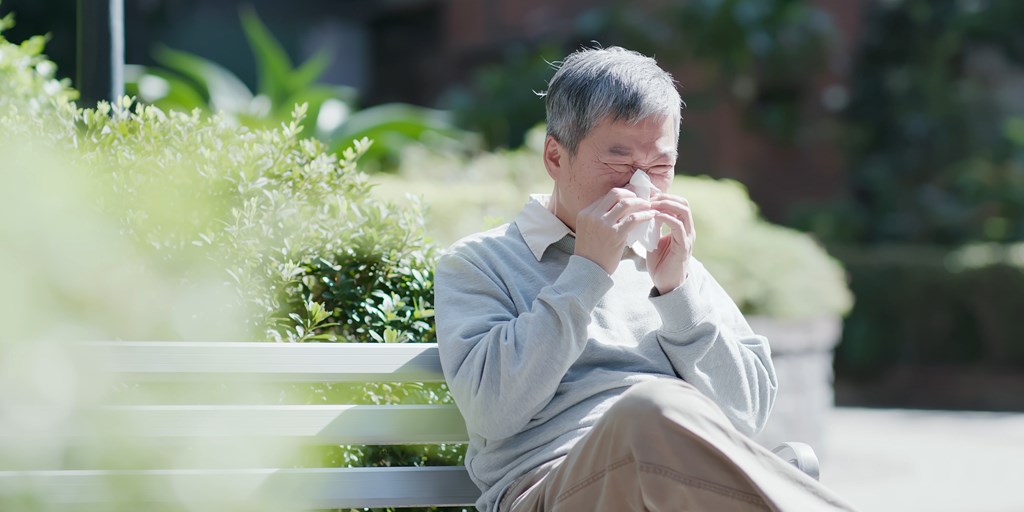Spring has sprung and so has allergy season. In many areas of the United States, spring allergies begin in February and last until the early summer. Tree pollination begins earliest in the year followed by grass pollination later in the spring and summer and ragweed in the late summer and fall. Mild winter temperatures can cause plants to pollinate early. A rainy spring can also promote rapid plant growth and lead to an increase in mold, causing symptoms to last well into the fall.
"It's already started," says Dr. Keyvan Ravakhah, internal medicine specialist and department of medicine chairman at St. Vincent Charity Medical Center. "All we need is a nice sunny, warm, breezy day and the pollen counts are going to jump up."
Trees are starting to pollinate and will continue to do so into June. Grasses typically begin pollinating in May, he said, adding that May and June are when spring allergies are typically at their worst.
"People with spring allergies typically feel pretty badly in May because there's an overlap of tree pollen, grass pollen and mold," Ravakhah said.
According to the Asthma and Allergy Foundation of America (AAFA), allergies are increasing. They affect as many as 30 percent of adults and 40 percent of children - that's more than 50 million people - in the United States.
The most common culprit for fall allergies is ragweed, a plant that grows wild almost everywhere, but especially in the Midwest. Ragweed pollen, which causes hay fever, usually hits peak levels in mid-September, but temperature changes and rain can lead to a prolonged season. An excessive amount of ragweed pollen causes prolonged runny noses, itchy throats, nasal congestion, sneezing, headaches and eye irritation for those with ragweed allergies.
Cleveland.com spoke with Dr. Keyvan Ravakhah, internal medicine specialist and department of medicine chairman at St. Vincent Charity Medical Center, about advice for surviving a particularly brutal allergy season.
"I've had many patients coming in thinking they have a cold or some sort of sinus infection, but in most cases  they are suffering from allergies," said Ravakhah.
they are suffering from allergies," said Ravakhah.
Here's everything you need to know to survive another allergy season.
Determining the correct diagnosis: cold and allergies?
Ravakhah explains that both illnesses cause similar symptoms such as a runny nose, congestion, sore throat and sneezing, but there are differences. Colds are viral infections that cause fever, aches, pains and cough. Allergies, or allergic rhinitis, is a condition where the airways in the nose become irritated to certain particles in the air as you breath. As a result, the sinuses and airways become inflamed (red and swollen) and produce a lot of mucus. This leads to runny nose, congestion, watery eyes, itchy throat and sinus headaches. These symptoms overlap with the symptoms of a cold so it can be difficult to determine the cause of your suffering.
Sneezing, itchy eyes (both eyes) and rashes are associated with allergies. Viral infections of the upper airways (nose, back of the throat, sinuses) present symptoms similar to allergies. However, as mentioned above, allergies have a “trigger”, and do not present with features other than that affecting the nose, sinuses, eyes and throat. Also, allergies would not cause things like fevers, chills, joint pain, tummy pain or vomiting to occur. Allergies do not usually cause a cough (unless it is after lying down – which is called a post nasal drip). Allergies tend to respond to nasal sprays and antihistamines while an infection may not.
"If you have a fever, have aches and pains, swollen glands or have a cough with phlegm, you should see a doctor," said Ravakhah.
An allergist can confirm a hay fever allergy with a skin test in which a small amount of the allergen is applied to the skin to see if it causes a rash or other reaction.
Know your triggers and avoid them.
There are a number of things that can trigger allergies. Well known types of pollen to cause allergic rhinitis are birch, maple, oak, sycamore, hickory and walnut. Ragweed and golden rod pollen dominate in the fall. Other common triggers include freshly cut grass, dust or animal fur and dander.
If you are allergic to pollen, try to avoid the outdoors when pollen activity is high. Use Google or a weather app on your mobile device to view daily pollen activity. If you live close to trees and grass, keep doors and windows closed during the day. When driving, keep the windows up. If possible, use an air conditioner to keep pollen out of your indoor environment. Be sure the air conditioner is set to recycle indoor air, and use a filter that traps allergens. If pollen counts are very high, wear a mask when outdoors.
"I wear a mask outdoors and shower at night to wash off pollen," said Ravakhah. "I also try to avoid freshly cut grass and after mowing the lawn I remove my clothing that has been exposed to pollen in the garage before entering the house."
Taking a shower after an outdoor exposure can remove the pollen that is stuck to your face and skin. Pets can be another trigger for allergy symptoms. In addition to the animal dander itself, animals can carry pollen on their fur so they may need to be washed or brushed before entering the home.
Pay attention to what makes your nose itch and to which activities and seasons bring about allergy symptoms. This will help determine the most effective way to get relief from symptoms.
Choosing the right treatment.
Allergy sufferers should take care of themselves by resting, staying hydrated and taking antihistamines or other over-the-counter allergy medication. Nasal sprays can also help, but take a few days to work. They work by reducing the inflammation and the mucus in the nose. Antihistamines are pills that also help with the inflammation and mucus. However, drowsiness is a common side effect so they aren't for everyone. There are other decongestant pills which may work short-term. These help by stopping the blood vessels from becoming enlarged which also reduces inflammation.
In severe cases of ragweed allergy, an allergist can prescribe shots that help the body build up a resistance to the allergen, or medication that must be started several weeks before ragweed season starts.
"A lot of patients come in and ask for antibiotics, but antibiotics are used to treat infections caused by bacteria. They are not used to treat allergies or infections caused by viruses," said Ravakhah. "Same goes for vitamins. Vitamins are good for a lot of things, unfortunately this is not one of them."
Consider home and herbal remedies.
Try flushing your nose with water frequently or as needed with a Neti pot. A Neti pot is a small pot filled with warm water and salt, used to rinse nostrils. It flushes out allergens, or particles that cause allergy symptoms. Camphor rubs are another option. Camphor used to be made by distilling the bark and wood of the camphor tree. Today, camphor is chemically manufactured from turpentine oil. It is used in products such as Vicks VapoRub. Camphor products can be rubbed on the skin (topical application) or inhaled.
Some herbal remedies can interact with other medications and should be taken with caution. Further caution should be taken if pregnant or nursing. If you are interested in these medications, speak with your primary care physician.
Click here to read the article from Cleveland.com.



